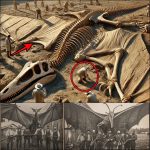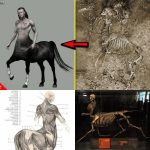Colossal Skeleton Unearthed in Spain: Dragon or Ancient Mystery?

After devastating floods swept through parts of Spain, a discovery along a riverbank has captured global attention: a colossal skeleton, featuring a massive skull and a long, serpentine spine, sparking awe, fear, and endless speculation. Witnesses describe the find as unlike anything previously documented, and the rapid disappearance of photos and reports from social media has only deepened the mystery. While officials claim the remains belong to an ancient whale, centuries-old legends of dragons in the region have reignited, leaving the public and researchers questioning what truths may lie beneath the surface.

The Discovery
Local residents stumbled upon the towering skeleton after floodwaters receded, revealing bones partially embedded in mud and sediment. The sheer size of the remains and the elongated spine immediately set it apart from typical marine or terrestrial creatures. Initial photographs, taken by eyewitnesses, circulated briefly online before reportedly disappearing, fueling claims of censorship or cover-ups. Authorities quickly sealed off the site, limiting access to professional archaeologists and officials.
Despite official statements attributing the skeleton to an ancient whale, the unusual features—particularly the elongated, flexible spine and massive skull with distinctive ridges—have led some experts and enthusiasts to question this explanation. Preliminary studies are underway to determine the skeleton’s species, age, and anatomical anomalies.
The Dragon Connection

Spain, like many cultures, has a rich tradition of dragon myths, often describing serpentine, powerful creatures that once roamed mountains, rivers, and skies. Some locals speculate that the skeletal remains may be linked to these legends, suggesting that myths could preserve fragments of forgotten biological or historical truths. While dragons are widely regarded as mythical, the possibility that extraordinary creatures inspired these tales cannot be entirely dismissed, especially in light of such a striking discovery.
Speculation and Controversy
The skeleton has sparked debate among scientists, historians, and conspiracy theorists alike. Skeptics maintain that the remains are most likely a prehistoric whale or other large marine animal, emphasizing the need for DNA testing, radiocarbon dating, and comparative anatomical studies. Supporters of the “dragon hypothesis” argue that unusual bone structures and the serpentine spine indicate a creature unlike any known whale or dinosaur, possibly representing a previously undocumented species.
Adding to the intrigue are reports of confiscated cameras, vanished photos, and restricted access to the site, which have fueled theories of a potential cover-up. Whether due to bureaucratic control or extraordinary secrecy, these actions have only amplified public fascination and speculation.
Implications for History and Myth
If confirmed as a species distinct from known whales or reptiles, the find could reshape our understanding of prehistoric life and its influence on folklore. It may provide evidence that myths, often dismissed as mere storytelling, were inspired by real creatures whose existence was gradually forgotten over centuries.
Conclusion
The colossal skeleton discovered along a Spanish riverbank remains an enigma, straddling the line between science, legend, and conspiracy. Whether an ancient whale, a mythical dragon, or an unknown species, the discovery challenges history and sparks global fascination. As experts continue investigations, the skeleton reminds us that nature—and human history—still holds secrets capable of inspiring awe, fear, and wonder.











